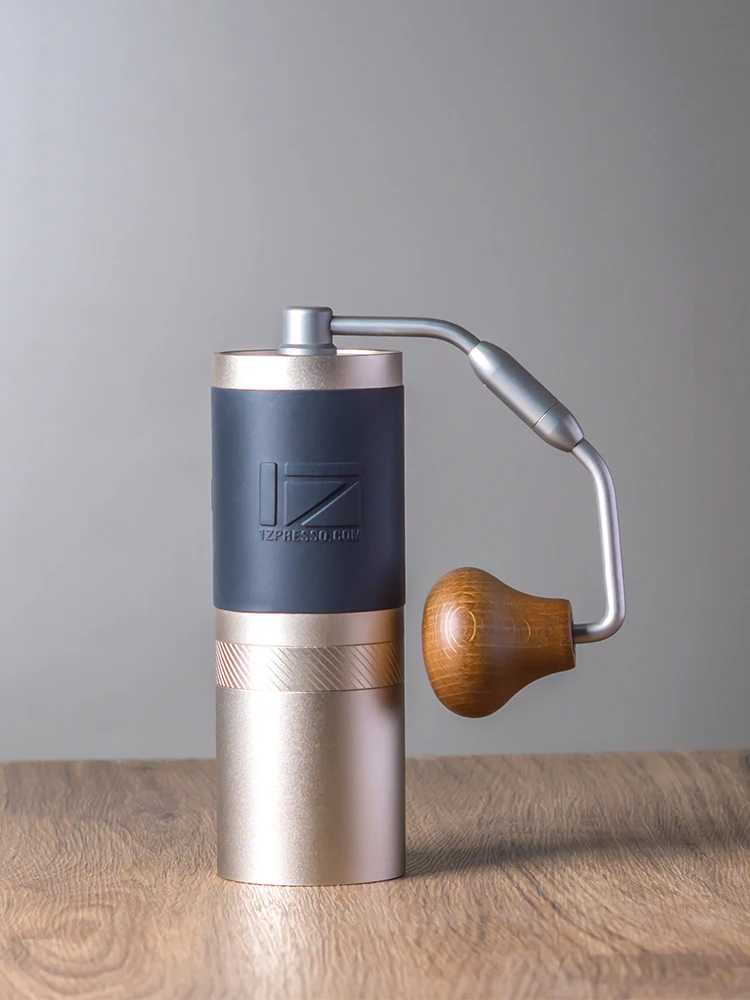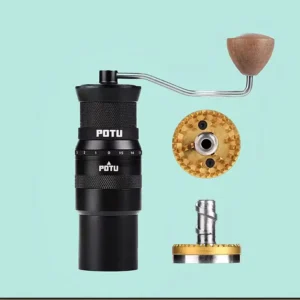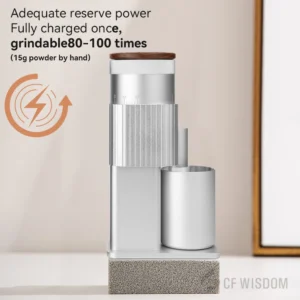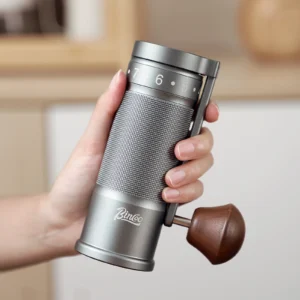The Critical Role of Consistent Coffee Grinding
Grind consistency refers to achieving uniform particle size throughout your ground coffee. When your coffee grounds are consistent, each particle extracts at the same rate, delivering balanced flavors in your cup. Inconsistent grounds, however, create a problem: smaller particles (fines) over-extract and become bitter, while larger chunks (boulders) under-extract and taste sour or weak.
This balance matters tremendously because grind consistency directly impacts three crucial elements of your coffee experience: flavor clarity, aroma development, and mouthfeel. When grounds extract evenly, you can taste distinct flavor notes rather than a muddled mix of over and under-extraction.
Many coffee lovers mistakenly believe that hand grinders can’t deliver consistent results. However, high-quality manual grinders can achieve excellent grind consistency fundamentals that rival electric models. The extraction percentage in your cup – typically ideal between 18-22% – hinges on this consistency.
Learning to control and improve your uniform grinding techniques empowers you to unlock the full potential of your coffee beans, regardless of brewing method. The factors we’ll explore determine whether your morning cup showcases the beans’ natural characteristics or masks them through inconsistent extraction.
Understanding Burr Quality and Design
Burrs form the heart of any coffee grinder, and their design significantly influences grind consistency. These precision-engineered components determine how effectively the beans are cut rather than crushed.
Different burr materials offer distinct advantages:
- Steel burrs: Provide exceptional sharpness, durability, and precision cutting. They excel at creating uniform grounds but can generate slight heat during extended grinding.
- Ceramic burrs: Remain cooler during operation and resist dulling over time. They typically require less maintenance but may be more brittle if dropped.
Burr geometry also plays a crucial role:
- Conical burrs: Feature a cone-shaped inner burr that rotates within an outer ring. This design excels at creating consistent particle size while generating less heat.
- Flat burrs: Have two parallel rings that grind beans between them. They can produce extremely uniform grounds but are less common in hand grinders.
Burr size directly affects consistency – larger burrs (38-48mm) generally produce more uniform particles than smaller ones (30mm) because they provide greater cutting surface area and stability.
The sharpness of cutting edges determines whether beans are precisely cut or partially crushed. Premium burrs have precisely manufactured edges that slice beans cleanly rather than creating irregular fragments and excess fines.
The critical impact of burr alignment cannot be overstated when assessing grinder performance. Even premium burrs will produce inconsistent results if not properly aligned. Understanding how burr diameter impacts coffee grind helps explain why larger burrs in manual coffee burr grinders typically produce more consistent results, especially for demanding brewing methods like espresso.
Burr Alignment and Stability Systems
Perfect burr alignment means maintaining both concentricity (burrs sharing the same center) and parallelism (burrs remaining exactly parallel to each other). When burrs aren’t properly aligned, the gap between them varies during rotation, creating inconsistent particle sizes.
In hand grinders, the central shaft holds the inner burr. Any wobble in this shaft—even slight movement measuring fractions of a millimeter—will cause the gap between burrs to fluctuate. This variability creates an uneven grind where some beans encounter a wider gap than others.
Premium grinders incorporate sophisticated stability systems to prevent this issue:
- Dual bearing systems that stabilize the shaft from both ends
- Reinforced mounting systems that secure burrs firmly in place
- Rigid frames that resist flexing or distortion during grinding
You can identify alignment issues by examining burr wear patterns. Unevenly worn burrs indicate alignment problems, with some sections showing more wear than others. Quality grinders maintain alignment through precise manufacturing tolerances and thoughtful engineering.
Frame rigidity significantly impacts consistency during grinding. When you apply force to the handle, a less rigid frame may flex slightly, changing the burr alignment temporarily. Premium grinders use materials and construction techniques that maintain stability under pressure.
Understanding the importance of burr alignment features helps explain why some grinders consistently outperform others, even when using similar burr sets. This stability system is what separates truly premium grinders from their less consistent counterparts.
Precision Adjustment Mechanisms
The adjustment mechanism in your hand grinder directly impacts consistency by determining how precisely you can control the gap between burrs. Two main systems exist:
Stepped adjustment provides distinct click positions as you adjust the grind size. Each click represents a specific distance between burrs. This system offers excellent repeatability—you can easily return to previous settings by counting clicks. However, it limits you to predetermined increments, which might not include the exact setting you need.
Stepless adjustment allows infinite control over grind size without fixed positions. While offering maximum precision, especially for espresso brewing, these systems can be more challenging to reproduce exactly when changing settings.
The resolution of click systems matters tremendously. Premium grinders offer micro-adjustments with each click representing just 15-30 microns of change, while budget models might move 100+ microns per click. For context, espresso often requires adjustments of just 20-30 microns to dial in properly.
Setting stability during grinding is equally important. Some grinders suffer from “setting drift,” where the adjustment gradually changes during use due to vibration. Quality grinders implement locking systems or tight tolerances to prevent this movement.

Exploring precision manual grinders reveals how these high-quality adjustment mechanisms improve your brewing consistency. The difference becomes particularly noticeable when fine-tuning for espresso, where minor adjustments significantly affect extraction.
Grinding Technique and User Variables
Even with excellent grinder design, your technique significantly influences grind consistency. How you handle your grinder introduces variables that can affect the final result.
Grinding speed and rhythm impact consistency in several ways. Grinding too quickly can create irregular force application and potential burr misalignment, while extremely slow grinding might result in particle fracturing as beans spend too long between burrs. Maintaining a steady, moderate pace produces the most consistent results.
Proper positioning matters tremendously:
- Hold the grinder vertically when possible
- Maintain stability through a firm grip without excessive pressure
- Support the grinder body rather than just the handle
Common technique mistakes that harm consistency include:
- Inconsistent cranking speed (speeding up and slowing down)
- Tilting the grinder during operation
- Applying uneven pressure or jerky movements
- Stopping and starting repeatedly
If you’re experiencing inconsistency issues in manual grinding, examine your technique first. Often, simple adjustments to your grinding approach can significantly improve results.
Practice makes perfect—developing muscle memory for consistent grinding technique takes time but rewards you with noticeably better coffee. Focus on smooth, steady motion rather than rushing through the grinding process.
Bean Properties and Their Impact
The beans themselves significantly influence grind consistency, interacting with your grinder’s capabilities in several important ways:
Bean density varies by origin, variety, and growing conditions. Denser beans (typically high-altitude arabicas) require more force to grind but often produce more consistent particles. Less dense beans can sometimes crumble unevenly.
Roast level dramatically changes grinding behavior:
- Light roasts: Harder, denser, and more brittle. They require more force but often produce cleaner cuts with less fines.
- Medium roasts: Balanced density and moderate brittleness, generally producing consistent results.
- Dark roasts: More fragile with developed oils. They require less force but can sometimes produce more irregular particles and fines.
Bean freshness plays a crucial role. Very fresh beans (1-7 days after roasting) contain significant CO2 gas that can create resistance and occasionally uneven grinding. Beans in their prime window (7-21 days post-roast) typically grind most consistently. Stale beans might produce more dust and irregular particles.
Oil content increases with darker roasts and longer rest periods. These oils can coat burr surfaces and impact cutting precision if not regularly cleaned.
For optimal consistency, select beans appropriate for your grinder’s capabilities. Entry-level hand burr grinders may struggle with extremely light roasts, while premium models handle a wider range of bean properties with ease.
Cleaning and Maintenance for Optimal Performance
Coffee oils and microscopic particles inevitably build up in your grinder’s burrs, affecting performance over time. This residue interferes with cutting precision and can create inconsistent results even in high-quality grinders.
Regular cleaning maintains optimal performance:
- Disassemble the grinder according to the manufacturer’s instructions
- Brush away loose grounds from burrs and grinding chamber
- Use a specialized grinder cleaning product or uncooked rice to remove oils
- Ensure all parts are completely dry before reassembling
- Check for proper burr alignment during reassembly
New burrs often require “seasoning”—processing several pounds of beans before reaching optimal performance. During this period, microscopic manufacturing burrs are smoothed out, resulting in progressively more consistent grinds.
Establishing a maintenance schedule prevents consistency problems:
- Quick cleaning (brushing out grounds): After every 1-2 uses
- Thorough cleaning (disassembly): Every 1-2 months for daily users
- Burr inspection: Every 6 months to check for wear or damage
Watch for signs of burr wear—increasing difficulty achieving fine grinds, more fines in your coffee, or visible dulling of cutting edges. Quality burrs typically last for 500-1000 pounds of coffee when properly maintained.
Proper cleaning techniques for manual coffee grinders ensure your equipment continues performing at its best, preserving both consistency and flavor clarity in every cup.
Diagnosing and Solving Common Consistency Issues
When your grind consistency suffers, identifying the specific problem leads to effective solutions. Here are common issues and their remedies:
Excessive Fines Production
* Symptoms: Muddy coffee bed, clogged filters, bitter taste
* Causes: Dull burrs, misalignment, excessive force while grinding
* Solutions: Clean thoroughly, check alignment, grind more gently, consider burr replacement if worn
Inconsistent Size Mid-Session
* Symptoms: Visually uneven grounds, mixed large and small particles
* Causes: Setting drift, inconsistent cranking, bean feeding issues
* Solutions: Check adjustment mechanism for stability, maintain steady grinding pace, ensure proper bean feeding
Stalling or Excessive Resistance
* Symptoms: Difficulty turning the handle, grinding stops completely
* Causes: Setting too fine, burrs touching, beans trapped between burrs
* Solutions: Adjust to coarser setting, check for foreign objects, ensure proper burr alignment
Sudden Consistency Change
* Symptoms: Previously good results suddenly deteriorate
* Causes: Component loosening, burr damage, bearing issues
* Solutions: Check all fasteners, inspect burrs for damage, examine bearing movement
Espresso coffee hand grinders face particular challenges with consistency due to the fine grind required. They benefit from more frequent maintenance and careful technique to maintain optimal performance.
When troubleshooting, address one variable at a time to identify the specific cause. This methodical approach prevents the frustration of changing multiple factors simultaneously and being unable to determine which solved the problem.
How to Test Your Grinder’s Consistency
You don’t need laboratory equipment to evaluate your grinder’s performance. These simple tests provide valuable feedback:
The Paper Towel Test:
1. Grind a small amount of coffee (10-15g)
2. Spread grounds evenly on a white paper towel
3. Look for visible size variations, particularly outliers
4. Check for clumps of fines or unusually large particles
Visual Inspection:
* Place grounds on a dark surface
* Use good lighting to examine particle uniformity
* Compare against reference photos of ideal consistency for your brew method
Sieve Testing (for enthusiasts):
* Use simple kitchen sieves of different mesh sizes
* Measure percentage of coffee captured by each sieve
* Compare results across different grind settings or grinders
For espresso, acceptable fine percentages range from 15-20%. Pour-over methods typically perform best with less than 12% fines. French press can tolerate higher percentages (up to 25%) without significantly impacting flavor.
Set realistic expectations based on your grinder’s price point. Entry-level grinders ($30-80) will produce more variable results, mid-range models ($80-150) offer good consistency, while premium grinders ($150+) deliver excellent uniformity suitable for all brewing methods.
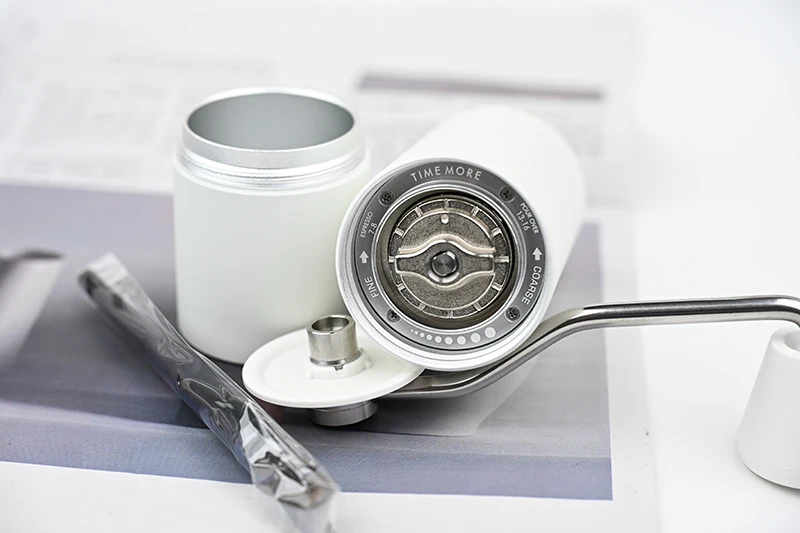
Why Do Premium Hand Grinders Achieve Better Consistency?
Premium hand grinders justify their higher price through specific engineering and manufacturing advantages that directly impact grind consistency:
Superior Material Quality:
* Higher-grade metals and alloys with tighter tolerances
* Precision-machined components versus cast or stamped parts
* Specialized bearings designed for minimal play and long life
Manufacturing Precision:
* Tolerances measured in microns rather than millimeters
* Computer-guided manufacturing processes
* Individual quality control testing of components
Engineering Design Priorities:
* Rigidity prioritized throughout the frame
* Dual bearing systems eliminating shaft play
* Concentric burr mounting systems
In entry-level grinders ($30-80), tolerances typically range from 0.1-0.3mm, while premium models ($150+) often maintain tolerances under 0.05mm. This precision directly translates to consistency in the cup.
The performance improvement follows a curve of diminishing returns—the jump from a $40 to a $140 grinder is typically more noticeable than from a $140 to a $300 model. However, for demanding brewing methods like espresso, these higher-end refinements make a meaningful difference.
Manual espresso grinders exemplify these premium engineering principles, delivering the exacting consistency necessary for espresso extraction without the cost of commercial electric grinders.
Can Hand Grinders Match Electric Grinders for Consistency?
A common misconception suggests that manual grinding inherently produces less consistent results than electric grinding. However, the reality is more nuanced:
Premium hand grinders can match or exceed the consistency of electric grinders in the same price range. A $200 hand grinder often delivers better particle distribution than a $200 electric model because more of the cost goes toward burr quality rather than motors and electronics.
Hand grinders excel in several areas:
* Reduced heat generation during grinding (no motor heat)
* Greater investment in burr quality at comparable price points
* Simpler mechanisms with fewer potential failure points
However, electric grinders maintain advantages for specific needs:
* Convenience for large quantities
* Reduced physical effort
* More stable operation for very fine espresso grinding
The quality comparison depends heavily on price bracket. Entry-level hand grinders ($30-80) generally underperform similarly priced electric models. However, mid-range and premium hand grinders ($100-300) often match or exceed electric grinders costing significantly more.
Understanding the differences between flat vs conical burr manual grinders provides additional context for this comparison, as burr design significantly impacts consistency in both manual and electric models.
Is Grind Consistency More Important for Certain Brew Methods?
Different brewing methods have varying sensitivity to grind consistency, which should inform your grinder selection:
Espresso demands the highest consistency due to:
* Very fine grind size that amplifies particle variation effects
* Short extraction time (20-30 seconds) providing little room for error
* High pressure that exaggerates channeling from inconsistent particles
* Potential extraction variances of 5-8% based on particle distribution alone
Pour-over methods (V60, Chemex, Kalita) show moderate sensitivity:
* Medium-fine grind with noticeable impact from inconsistency
* Sequential extraction particularly affected by fines migration
* Potential extraction variance of 3-5% based on grind consistency
Immersion methods (French press, AeroPress) demonstrate greater tolerance:
* Coarser grinds with less surface area variation
* Longer contact time equalizing extraction differences
* No pressure or flow issues to exacerbate inconsistency
* Potential extraction variance of 1-3% based on grind consistency
This relationship explains why coffee enthusiasts often upgrade their grinder when moving to espresso brewing—the definitive guide to espresso grind consistency reveals how this demanding method requires exceptional uniformity for balanced extraction.
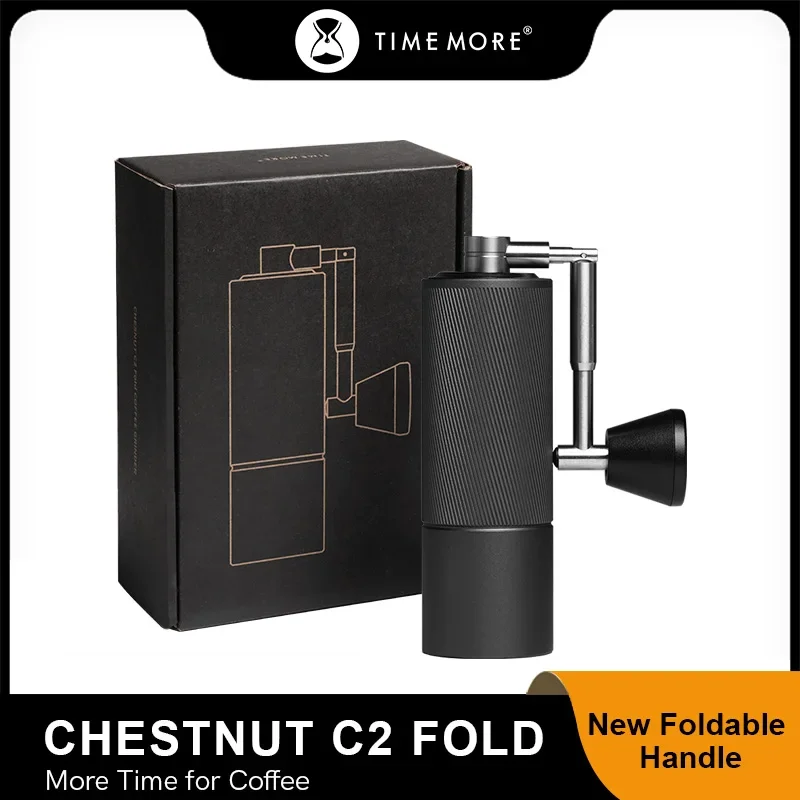
Summary: Prioritizing Factors for Your Next Hand Grinder Purchase
When selecting a hand grinder for optimal consistency, prioritize these factors in order of importance:
Burr Quality and Material: The foundation of consistency; prioritize precision-manufactured steel or ceramic burrs from reputable manufacturers
Alignment and Stability Systems: Look for dual bearings, reinforced mounting, and rigid construction that maintains alignment under pressure
Adjustment Mechanism: Seek precise, stable systems with fine increments appropriate for your preferred brewing methods
Overall Construction Quality: Select grinders with solid materials, minimal plastic components in critical areas, and purposeful engineering
Fine Adjustment Hand Grinder, Precision Manual Grinder, Travel Coffee Grinder
Price range: $185.11 through $494.63 Select options This product has multiple variants. The options may be chosen on the product pageHand Burr Grinder, Hand Crank Coffee Grinder, Manual Espresso Grinder, Portable Coffee Grinder
Price range: $262.72 through $300.22 Select options This product has multiple variants. The options may be chosen on the product pageManual Burr Mill, Manual Coffee Grinder Stainless Steel, Manual Coffee Mill Grinder, Mechanical Coffee Grinder
Price range: $127.26 through $130.32 Select options This product has multiple variants. The options may be chosen on the product pageHand Burr Grinder, Manual Coffee Grinder Stainless Steel, Precision Manual Grinder
Price range: $183.64 through $187.52 Select options This product has multiple variants. The options may be chosen on the product page
Budget considerations naturally affect these priorities:
* Entry-level ($30-80): Focus on basic burr quality and functional design
* Mid-range ($80-150): Expect good alignment, stable adjustment, and consistent results for most brew methods
* Premium ($150+): Invest in superior engineering for exceptional consistency across all brewing styles
Your brewing preferences should guide your selection. Espresso enthusiasts benefit most from premium models with exceptional stability, while those brewing primarily with immersion methods might find excellent value in mid-range options.
Achieving perfect grind consistency requires both quality equipment and proper technique. By understanding these factors, you’re now equipped to select a hand grinder that delivers the consistency necessary for exceptional coffee, cup after cup.

